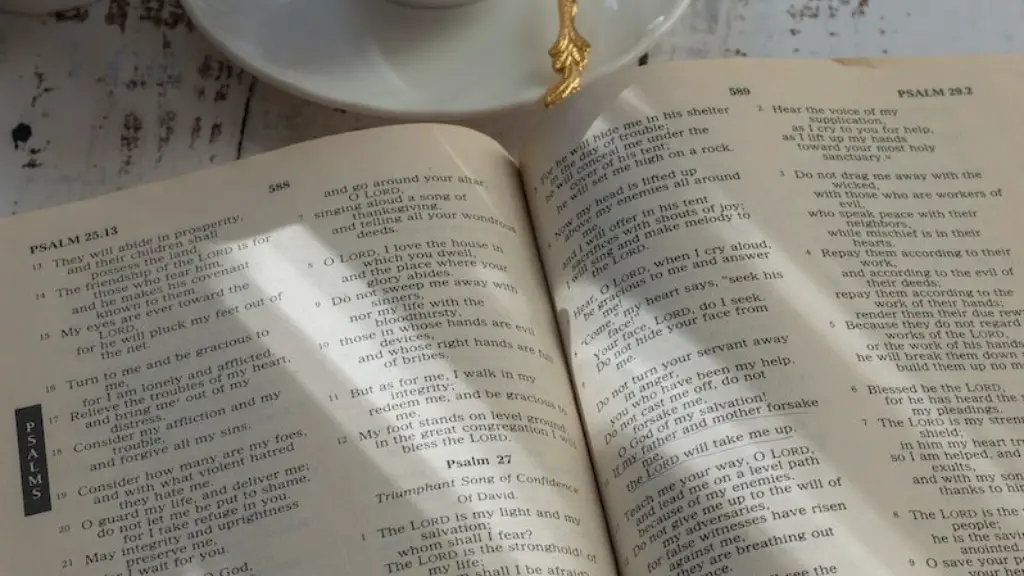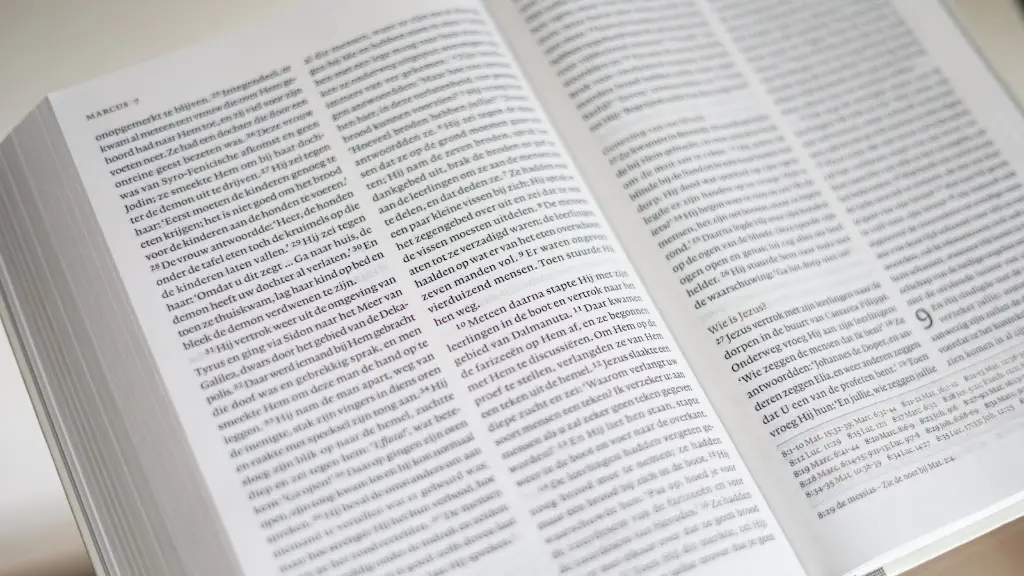Baal, which means “lord” or “master,” was the name of various gods known from the ancient Middle East, including the Levant and Phoenicia. In the Bible, Baal is primarily known as a storm god, referred to as the “Lord of the Heavens;” he was seen as the provider of fertility and the protector of agricultural land. Baal was also known as a “Lord of Fire” who, while offering protection and fertility, also accepted human sacrifices as part of his worship.
Despite his major importance in the ancient world, Baal remains a mysterious figure in the Bible. He is generally associated with the destruction of a particular people, such as the Canaanites, who are believed to be the first civilisation to worship him. The Hebrew Bible mentions Baal in several passages, most commonly as an adversary of the God of Israel; however, the exact significance of Baal in the Bible is open to interpretation.
Although there is debate among scholars regarding the meaning of Baal in Biblical passages, most experts agree that he was a powerful deity in the pantheon of the ancient Middle East. Some scholars argue that Baal was an agricultural deity who was associated with rain, fertility, fertility-rites, and the afterlife. He was seen as a powerful protector of the land, with his main function to ensure the fertility of the land and the prosperity of the people.
The worship of Baal was widespread in the ancient world and was embraced by a range of cultures, ranging from the Phoenicians to the Israelites. It is believed that the Israelites adopted the worship of Baal under the influence of the neighbouring Canaanite culture. This is why Baal is often seen as an enemy of God in the Bible; his worship was seen as threatening to the purity of Judaism. The Israelites rejected Baal and instead focused their attention on worshipping the God of Israel.
However, some scholars argue that conventional interpretations of Baal’s role in the Bible have been overly simplistic. They point out that Baal was often invoked in the prophetic literature of the Bible, and suggest that he was used as a rhetorical tool to express the wrath of God towards idolaters. In other words, rather than being an enemy of God, Baal was seen as an example of the power of idolatry and the need for God’s faithful followers to reject it. In this way, Baal is seen as an example of “the power of evil” that is spoken of in the Bible.
Despite the differences in opinion regarding the role of Baal in the Bible, most agree that he was an important deity in the ancient world. His legacy has lived on in the modern world, with the name of “Baal” being often used as a synonym for “lord” or “prince.” Additionally, some scholars have argued that Baal was seen as a symbol of power and fertility throughout the ancient world, with his worship being a part of a wider cult of fertility and the afterlife. It is clear that Baal was an important figure in the ancient Middle East, and his role in Bible still remains an important topic of study and debate.
Baal’s Role In Ancient Cultures
Baal was a major figure in the religions of a number of ancient cultures, particularly in the region known as ‘Canaan.’ This region included modern-day Syria, Lebanon, Jordan, and Israel, and was populated by a number of different peoples and cultures. In Canaan, Baal was seen as the major deity, the Lord of the wind and rains, and the provider of fertility. It is believed that he was worshiped not only by the people of Canaan, but also by the Phoenicians and Hebrews.
The worship of Baal was centred around agricultural fertility, with some cultic practices also being associated with his worship. These included dances, festivals, and animal sacrifice. It is believed that some of these cultic practices were adopted by the Hebrews, particularly in times of national distress. This could explain why there are references in the Bible to Hebrews sacrificing to Baal and Asherah, suggesting a form of syncretism between the Canaanite worship of Baal and the worship of YHWH, the God of Israel.
Despite its widespread nature, the worship of Baal was frowned upon by the Biblical prophets, who warned against the “false gods” such as Baal and Asherah. This could be attributed to the fact that Baal was associated with a number of fertility cults, and the prophets were eager to distance the Hebrews from such practices. This is why Baal is seen as an opponent of YHWH in the Hebrew Bible — a symbol of idolatry and of the need for the Israelites to remain true to their faith.
However, it is important to be aware of the fact that Baal was an important figure in the ancient world who, contrary to popular belief, was not completely rejected by the Bible. For example, the prophets often invoked the power of Baal in their writings, and Elijah, one of the most revered prophets, is even said to have subjected Baal to a contest to prove which of the two was the true God and the winner of the people’s worship. In this way, Baal’s role in the Bible was complex, and he remains an important topic of study for scholars of the Bible and the ancient Middle East.
The Legacy Of Baal
The worship of Baal was a major part of ancient religion in the Middle East, and his legacy has lived on in various forms. For example, the name “Baal” is often used today to refer to anyone in a position of power, such as the Lord, a prince, or a master. Additionally, the name “Baal” is often used in a pejorative sense, to refer to anyone who is accused of attempting to control or manipulate others through their power or influence.
In terms of literature, Baal remains an important figure in the Bible and other texts. In the Bible, for example, he is often cited as an example of false beliefs and idolatry. Additionally, he is often invoked by the prophets to express the righteous anger of God and to warn the Israelites against straying from the path of righteousness. Finally, Baal is a major figure in post-biblical literature, with his presence being felt in a range of texts from the Hebrew Bible to modern Jewish literature.
In conclusion, Baal remains an important figure in the world of religion and literature. He was a major deity in the ancient Middle East, with his worship being embraced by a number of cultures, including the Canaanites and Hebrews. While his worship was frowned upon by the prophets of the Bible, he is still remembered today through his legacy in literature and popular culture. For scholars of the ancient Middle East, Baal will remain an important figure in the pantheon of gods and a source of debate and interpretation.
The Relationship Between Baal and YHWH
The relationship between Baal and YHWH, the God of Israel, is a complex one, with scholars having different interpretations. On the one hand, Baal is depicted as an opponent of YHWH and his worship seen as a snare for the Israelites, leading them to stray from the righteous path. However, some scholars have argued that the prophets of the Bible used Baal as a rhetorical device to express the glory of YHWH and the might of his power.
At one point, Elijah, one of the most reveredProphets of Israel, held a contest between YHWH and Baal to prove which of the two was the true God and the winner of the people’s worship. Ultimately, YHWH was victorious, and Baal went from being a symbol of power to a symbol of idolatry. The story of Elijah depicts the ultimate rejection of Baal’s worship and serves as an example of theIsraelites’ faithfulness to YHWH.
Ultimately, the relationship between Baal and YHWH was a complicated one. On the one hand, Baal was seen as an enemy of YHWH, with his worship often leading to idolatry and moral depravity. On the other hand, he was used as a rhetorical device to demonstrate the power of YHWH and to warn against idolatrous practices. In this way, Baal remains an important figure in the nuanced relationship between the worship of YHWH and the worship of other gods in the Bible.
The Symbolic Significance Of Baal
In the Bible, Baal is often seen as a symbol of power and a source of fertility.Most scholars agree that he was an agricultural deity, connected to the fertility of the land and the successful harvest of crops. He was worshipped as a protector of the land and the people, with his power seen as a source of prosperity. This is why Baal was a major figure in the pantheon of gods in the ancient Middle East and his worship widely adopted.
From a symbolic point of view, Baal is often seen as a symbol of idolatry and a warning against straying from the path of righteousness. This is why he is seen as an enemy of YHWH and the object of righteous wrath in the Bible. However, some scholars have also suggested that his power and glory demonstrate the might of YHWH and emphasize the need for faithfulness to Him. In this sense, Baal is a figure of complexity and a source of debate and interpretation in the study of the Bible and the religion of the ancient Middle East.
In conclusion, Baal remains a mysterious and fascinating figure in the Bible and the religions of the ancient Middle East. He was a major figure in the pantheon of gods, seen as a source of power and fertility, and widely worshipped by a range of cultures in the region. He has also been used as a symbol in the Bible, viewed as a warning against idolatry and a demonstration of the righteous power of YHWH. In this way, Baal is a multifaceted figure whose role in the ancient world is still open to interpretation.
Baal And Modern Culture
The legacy of Baal lives on in the modern world, with the name “Baal” often used to refer to someone in a position of power, such as a ruler or master.Additionally, the name “Baal” is used in a pejorative sense to refer to anyone who is seen as attempting to control or manipulate others through their power or influence. It is clear that how we understand Baal in the modern world has been shaped by his role in the Bible, with his name often associated with power and idolatry.
In terms of literature, Baal remains an important figure in the Bible and is often cited as a symbol of false beliefs and idolatry. Additionally, he is often invoked by the prophets to express the righteous anger of God and to warn against idolatrous practices. Finally, Baal is a major figure in post-biblical literature, featuring prominently in Hebrew Bible, Jewish literature, and modern mythologies, such as those of the Canaanites.
In conclusion, the legacy of Baal is seen in the modern world in many ways. He is often seen as a symbol of false beliefs





